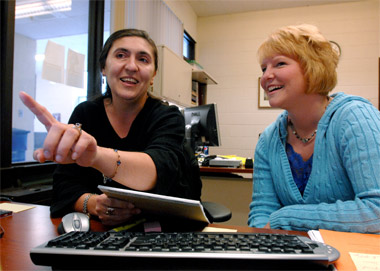
Knowledge network -- Sylvia Secchi (left) and her undergraduate research assistant, Kristen L. Woods, review material Woods has turned up in her hunt for online information on policies promoting renewable energy. (Photo by Russell D. Bailey) Download Photo Here
March 05, 2010
Student makes most of research opportunity
CARBONDALE, Ill. -- She’s been on the hunt for just a few months, but Kristen L. Woods, a 21-year-old senior in agribusiness economics at Southern Illinois University Carbondale, has already figured one thing out: It’s hard to follow a federal money trail.
“They don’t just put it out there,” Woods said.
“Sometime it’s frustrating, because I know that the information is out there somewhere. I try to follow the sources in papers I’ve read to dig deeper and find more details. I’m just amazed at how much money has been spent.”
Woods, who hails from Newton, where her family runs a small farm, works as an undergraduate research assistant for agricultural economist Sylvia Secchi, helping gather information on the role of government policy in promoting renewable energy production over the last 35 years.
“The goal is to publish a scholarly journal article on public sector initiatives aimed at fostering production of a variety of renewable energy sources -- biofuels, wind, solar, geothermal,” Secchi said.
“To date, the only published research in this area focuses on one specific resource at a time. The overall perspective is missing. Understanding the lessons from past energy policy will help improve the effectiveness of future energy policy.”
Woods’ part of the puzzle focuses on federal and state efforts to assist alternative energy producers -- from research and development grants to taxes, subsidies, loans and legislation — and on how actual energy production has changed in response. Using online search tools, Woods is sifting through both published and unpublished material, focusing particularly on documents produced by governmental agencies. After completing that research, she will work with Secchi to assemble what she has learned into databases and a chronology.
Secchi chose Woods, who also serves as president of the Agriculture Student Advisory Council and as a college “agbassador,” because of her reputation within the college and because of Woods’ stellar grade-point average. She has not been disappointed.
“She is the hardest-working, go-getter overachiever I ever saw,” Secchi said.
“She is not just doing what I ask, she is working hard to understand the issues. She is so good it is scary.”
Woods, who drives a 2000 Ford Taurus that runs on a mix of ethanol and gas, said she applied for the assistantship because she perceives renewable energy as a “hot topic.”
“I think this knowledge will be relevant even if I don’t use it in a job per se,” Woods said.
Woods meets weekly with Secchi to get specific assignments and spends about eight hours each week on the work. Since starting in September, Woods said she’d seen a “big jump” in both her ability to translate the jargon she encounters and in her organizational skills. But by far the biggest benefit has come from the knowledge she’s soaked up from Secchi as they discuss what she’s found.
“You get that one-on-one time with your professor, and you learn a lot about a specific topic,” she said.
“It’s a good way to increase your educational experience because if all you do is go to class, you don’t get the depth you do when you do your own research.”
To learn more about undergraduate research opportunities at SIUC, visit http://reach.siuc.edu/
